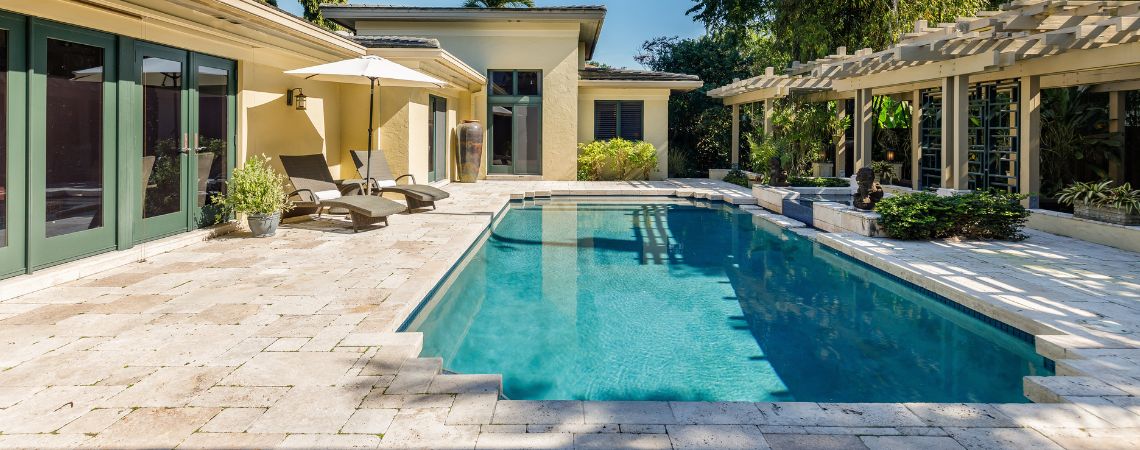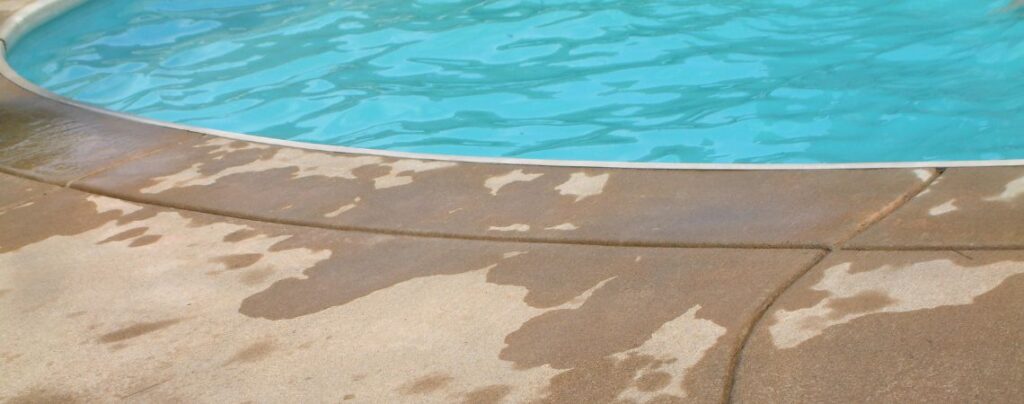If your once-inviting pool is starting to show signs of damage, it’s time to resurface it. On average, after every 7 to 15 years, you should consider gunite pool resurfacing, depending on the pool material and maintenance.
Are you planning for pool resurfacing, but wondering how much time it will take? Well, the time for pool plaster or gunite pool resurfacing depends on many things, including age, wear, environment, and more. So, it’s not a one-size-fits-all; every homeowner has different needs for pool resurfacing.
Some pools get damaged earlier than 10 years and need repair, while others stay strong even after 15 years. If you see some cracks on the pool, don’t wait for them to widen or the pool to fall apart. Consider pool resurfacing immediately to avoid any further damage.
In this article, we will discuss how to decide the time to resurface pools in Florida and other areas.

While there is no fixed time for resurfacing a pool, some pool damage signs can help you know if it needs replastering or not. What are those signs?
Old pools often require resurfacing. Due to constant exposure to water, chemicals, and hot weather, the pool surface gets damaged with age. The lifespan for most swimming pools in Florida is around 7 to 15 years, depending on the materials used and the maintenance undertaken on the pool.
The frequency of using a pool accelerates its wear and tear. For instance, swimming regularly, throwing pool parties, and even child usage can greatly increase the deterioration rate of the pool surface. More usage of the pool means more chemical is needed to keep the water clean, which in turn deteriorates the pool surface.
There are many options when it comes to building a pool in Florida, and the material you choose for the pool surface also decides the pool replastering time. The most popular and durable pool surfaces are plaster, pebble, and quartz.
Plaster, being affordable, requires pool resurfacing in Parkland sooner than a tile pool surface. Pebble tech pool surface lasts longer and requires pool replastering in Florida in 10-15 years.
Maintaining the swimming pool water is just as important as taking care of the structure. Any pool surface will get damaged without regular testing and adjustment of water pH levels.
If the water is too acidic or has high amounts of chlorine, it creates stains, etch marks, and rough patches on the surface. So, when you see any stains or rough patches, it means it’s time for pool resurfacing.
In Florida, the weather can be very hot and humid, which can lead to algae formation on the pool surface, which damages it if not cleaned properly. Moreover, rain, sunlight, and temperature changes can cause weakening, fading, silting, cracking, and erosion of pool surface materials. In this case, you need a regular pool resurfacing after a fixed interval of time, which can be 5 years, 7 years, or more. It varies from pool to pool.

Pools eventually show signs of wear and tear, no matter how well they are maintained. A safe, enjoyable swimming experience depends on knowing when it’s time to resurface. Here are the most common signs that your pool may need resurfacing or replastering:
If your once-bright pool looks dull and faded, it means it needs a replastering or resurfacing. When a pool witnesses many summers, its surface often fades due to heat and other environmental factors.
Small hairline cracks might not seem like a big deal—until they start spreading. Minor cracks can potentially permit small amounts of water to escape into the pool’s structure, which leads to damage. Other signs that may indicate the need for pool resurfacing are peeling or flaking.
Rough pool surfaces often become a breeding ground for mold and algae. It’s not good to swim in a pool whose surface is covered with mold. So, it is better to choose pool resurfacing Boca Raton to make the surface smooth and free from mold buildup.

We understand that pool resurfacing feels like a big task to you, but delaying it can cause you big trouble. Here’s what happens when you keep putting it off:
These are just tiny cracks, we’ll see later – do you also think like it? Well, don’t make this mistake, as ignoring small cracks can turn into big trouble over time. Water slowly seeps in, widening gaps and weakening the entire pool surface. Over time, this can cause serious structural damage that costs you more than the pool resurfacing cost.
With the increase in rough surface, mold and algae will strongly cover the surface of the pool and cause damage if not treated in time. Once they find a permanent home in cracks and pits, it becomes hard to clean them. And, your pool water starts to look murky and becomes unsafe for swimming.
The worse your pool surface gets, the more you need to spend on chemicals, water, cleaning tools, and other maintenance. As the damage increases, your pool will demand more frequent maintenance and quick fixes, which can seriously add up over time. It means you need to pay more to keep the pool working. So, better to get it resurfaced on time to avoid frequent maintenance and repairs.
Yes, you read it right! A damaged pool surface can cause scrapes and cuts on your feet or other body parts, especially for kids. This is not a summer memory you want. So, make sure you choose to resurface your pool on time before it starts causing problems to you or your kids.
Are you planning to sell your property in the coming months? Well, then, with a damaged pool, you may not get the best resale value for your property. On the other hand, if you sell property after pool resurfacing, the chances are hight that you get a higher value for the same property.
At first, patchwork seems attractive to many pool owners, especially when ther are few cracks or rough spots in the pool. Of course, it’s cheaper and faster than resurfacing, but it does not last longer and is a temporary band-aid.
In Florida’s hot and humid climate, patched pool areas can deteriorate faster, and you need to spend more money again to cover cracks. So, in our opinion, patchwork is not an optimal option either; it doesn’t give a new, refreshed look to an otherwise older pool.
Full pool resurfacing is like giving your pool a whole new look that lasts longer. Your trusted pool contractor strips the old, damaged layer and applies a new pool finish across the entire surface. Upfront pool resurfacing costs can be high, but it gives an even look to your pool while offering you peace of mind from multiple patchworks. Plus, it makes pool maintenance much easier for pool owners in Florida.
So, which is better?
Without any doubt, pool resurfacing is better in Florida.
Pool replastering is necessary to keep your pool looking fresh and new all the time. Also, it provides you with a safe environment to enjoy the water during hot summer days. Hope now you know when to get your pool resurfaced. Check for any damaging signs, consider the pool age, and look for chemical buildups. All these signs indicate that you should call a professional for pool resurfacing in Florida.
A well-maintained pool adds value to your property, gives you peace of mind, and helps you avoid emergency repairs. Plus, nothing beats the feeling of diving into a pool that looks brand-new!
At Epic Watershapes, we analyze your pool and assess its condition before starting the pool plaster work in Florida. Our team of highly skilled pool experts explains everything to you and gives you a time estimation to complete the pool plastering. While specific timelines for gunite pool resurfacing vary from project to project, we are committed to finishing the work by the deadline.
For most backyard pools, resurfacing can be completed in as little as 7 to 10 days, depending on the size, finish type, and any extra repairs needed. To know the most accurate estimate on how quickly your pool can be resurfaced, it’s best to contact us directly.
You can paint your pool, but it is totally different than resurfacing. In painting, you will simply give the pool a new look, without addressing cracks or any other damage. But, in pool resurfacing, expert pool contractors like us fill all the gaps and cracks to prevent any kind of leakage in the pool. It is a long-term solution that not only gives your pool a brand new look, but also strengthens the structure, smooths rough spots, and improves durability.
There are basically four types of pool finishing that are pebble, plaster, quartz, and tile. Every pool resurfacing material has its own pros and cons. If you are looking for a long-lasting pool finish, then tile and quartz can be a great option. They last for about 15-20 years and look luxurious as well.
On the other hand, if you have a limited budget and still want a durable option, then go for a plaster pool finish. It gives you the option to choose a custom color for resurfacing the pool. Also, plaster lasts for 10 plus years, which makes it a good and affordable choice for many pool owners.
We are experts in any type of pool resurfacing in Florida. Also, our team of expert pool professionals guides you on the best pool resurfacing depending on its condition.
Yes, pool resurfacing can fix surface leaks, especially if they are due to cracks or wear in the plaster. But, if leaks are in the plumbing pipes, then pool resurfacing is not able to fix them. For that, you need to call a plumber to fix a leak in the plumbing system.
It’s better to call a professional pool contractor like Epic Watershapes, who will do a complete inspection of your pool to determine whether resurfacing is enough or if repairs are needed.
Yes, we are experts in resurfacing old pools in Florida. It is the best way to increase the life of any backyard pool while keeping it operational for years. Moreover, resurfacing gives your old pool a fresh new look, which attracts kids to swim in summer and all year long. You can safely enjoy pool time with family and friends.
Once your pool gets resurfaced, follow the following tips to keep it safe for longer: